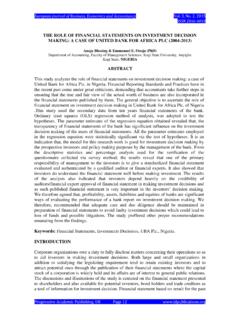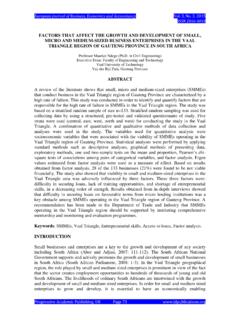Transcription of GRAPH THEORY IN COMPUTER SCIENCE - AN OVERVIEW
1 International Journal of Academic Research and Reflection Vol. 3, No. 4, 2015 ISSN 2309-0405 Progressive Academic Publishing, UK Page 55 GRAPH THEORY IN COMPUTER SCIENCE - AN OVERVIEW PHD Candidate Besjana Tosuni Faculty of Economics University Europian of Tirana ABSTRACT The field of mathematics plays vital role in various fields. One of the important areas in mathematics is GRAPH THEORY which is used in structural models. We give a survey of GRAPH THEORY used in COMPUTER sciences . The survey consists of a description of particular topics from the THEORY of GRAPH of the areas of COMPUTER SCIENCE in which they are used. However, for each described THEORY we indicate the fields in which it is used ( in modelling and searching Internet, in COMPUTER vision, pattern recognition, data mining, multiprocessor systems, statistical databases, and in several other areas).
2 This paper gives an OVERVIEW of the applications of GRAPH THEORY in heterogeneous fields to some extent but mainly focuses on the COMPUTER SCIENCE applications that uses GRAPH theoretical concepts. Various papers based on GRAPH THEORY have been studied related to scheduling concepts, COMPUTER SCIENCE applications and an OVERVIEW has been presented here. Keywords: Graphs, network, application of graphs, GRAPH algorithms, bipartite GRAPH etc. INTRODUCTION GRAPH THEORY is an old subject, but one that has many fascinating modern applications. GRAPH theoretical ideas are highly utilized by COMPUTER SCIENCE applications. Especially in research areas of COMPUTER SCIENCE such data mining, image segmentation, clustering, image capturing, networking. These applications in turn have offered important stimulus to the development of the field, leading to generalizations of important GRAPH theoretical concepts and challenging questions about them.
3 The powerful combinatorial methods found in GRAPH THEORY have also been used to prove significant and well-known results in a variety of areas in mathematics itself. Modeling of network topologies can be done using GRAPH concepts. In the same way the most important concept of GRAPH coloring is utilized in resource allocation, scheduling. This paper has been divided into two sections. First section gives the historical background of GRAPH THEORY and some applications in scheduling. Second section emphasizes how GRAPH THEORY is utilized in various COMPUTER applications. History of GRAPH THEORY The origin of GRAPH THEORY started with the problem of Koinsber Bridge, in 1735. This problem lead to the concept of Eulerian GRAPH . Euler studied the problem of Koinsberg bridge and constructed a structure to solve the problem called Eulerian GRAPH . In 1840, Mobius gave the idea of complete GRAPH and bipartite GRAPH and Kuratowski proved that they are planar by means of recreational problems.
4 The concept of tree, (a connected GRAPH without cycles was implemented by Gustav Kirchhoff in 1845, and he employed GRAPH theoretical ideas in the calculation of currents in electrical networks or circuits. In 1852, Thomas Gutherie found the famous four color problem. Then in 1856, Thomas. P. Kirkman and William R. Hamilton studied cycles on polyhydra and invented the concept called Hamiltonian GRAPH by studying trips that visited certain sites exactly once. In 1913, H. Dudeney mentioned a puzzle problem. Even though the four color problem was invented it International Journal of Academic Research and Reflection Vol. 3, No. 4, 2015 ISSN 2309-0405 Progressive Academic Publishing, UK Page 56 was solved only after a century by Kenneth Appel and Wolfgang Haken. This time is considered as the birth of GRAPH THEORY . Caley studied particular analytical forms from differential calculus to study the trees.)
5 This had many implications in theoretical chemistry. This lead to the invention of enumerative GRAPH THEORY . Any how the term GRAPH was introduced by Sylvester in 1878 where he drew an analogy between Quantic invariants and covariants of algebra and molecular diagrams. In 1941, Ramsey worked on colorations which lead to the identification of another branch of GRAPH THEORY called extreme GRAPH THEORY . In 1969, the four color problem was solved using computers by Heinrich. The study of asymptotic GRAPH connectivity gave rise to random GRAPH THEORY . Algorithms and GRAPH THEORY The major role of GRAPH THEORY in COMPUTER applications is the development of GRAPH algorithms. Numerous algorithms are used to solve problems that are modeled in the form of graphs. These algorithms are used to solve the GRAPH theoretical concepts which intern used to solve the corresponding COMPUTER SCIENCE application problems.
6 Some algorithms are as follows: 1. Shortest path algorithm in a network 2. Finding a minimum spanning tree 3. Finding GRAPH planarity 4. Algorithms to find adjacency matrices. 5. Algorithms to find the connectedness 6. Algorithms to find the cycles in a GRAPH 7. Algorithms for searching an element in a data structure (DFS, BFS) and so on. Various COMPUTER languages are used to support the GRAPH THEORY concepts. The main goal of such languages is to enable the user to formulate operations on graphs in a compact and natural manner. Some GRAPH theoretic languages are: 1. SPANTREE To find a spanning tree in the given GRAPH . 2. GTPL GRAPH Theoretic Language 3. GASP GRAPH Algorithm Software Package 4.
7 HINT Extension of LISP 5. GRASPE Extension of LISP 6. IGTS Extension of FORTRAN 7. GEA Graphic Extended ALGOL (Extension of ALGOL) 8. AMBIT To manipulate digraphs 9. GIRL GRAPH Information Retrieval Language Vertex Coloring Vertex coloring is one of the most important concepts in GRAPH THEORY and is used in many real time applications in COMPUTER SCIENCE . Various coloring methods are available and can be used on requirement basis.
8 The proper coloring of a GRAPH is the coloring of the vertices and edges with minimal number of colors such that no two vertices should have the same color. The minimum number of colors is called as the chromatic number and the GRAPH is called properly colored GRAPH . Figure 1. International Journal of Academic Research and Reflection Vol. 3, No. 4, 2015 ISSN 2309-0405 Progressive Academic Publishing, UK Page 57 List coloring In list coloring problem, each vertex v has a list of available colors and we have to find a coloring where the color of each vertex is taken from the list of available colors. This list coloring can be used to model situations where a job can be processed only in certain time slots or can be processed only by certain machines. Minimum sum coloring In minimum sum coloring, the sum of the colors assigned to the vertices is minimal in the GRAPH .
9 The minimum sum coloring technique can be applied to the scheduling THEORY of minimizing the sum of completion times of the jobs. The multicolor version of the problem can be used to model jobs with arbitrary lengths. Here, the finish time of a vertex is the largest color assigned to it and the sum of coloring is the sum of the finish time of the vertices. That is the sum of the finish times in a multicoloring is equal to the sum of completion times in the corresponding schedule. Time table scheduling Allocation of classes and subjects to the Teachers is one of the major issues if the constraints are complex. GRAPH THEORY plays an important role in this problem. For t Teachers with n subjects the available number of p periods timetable has to be prepared. This is done as follows. A bipartite GRAPH (or bigraph is a GRAPH whose vertices can be divided into two disjoint sets U and V such that every edge connects a vertex in U to one in V; that is, U and V are independent sets) G where the vertices are the number of Faculty say t1, t2, t3, t4.
10 Tk and n number of subjects say n1, n2, n3, n4, .. nm such that the vertices are connected by pi edges. It is presumed that at any one period each Teacher can teach at most one subject and that each subject can be taught by maximum one Teacher. Consider the first period. The timetable for this single period corresponds to a matching in the GRAPH and conversely, each matching corresponds to a possible assignment of Teacher to subjects taught during that period. So, the solution for the timetabling problem will be obtained by partitioning the edges of GRAPH G into minimum number of matching. Also the edges have to be colored with minimum number of colors. This problem can also be solved by vertex coloring algorithm. The line GRAPH L(G) of G has equal number of vertices and edges of G and two vertices in L(G) are connected by an edge iff the corresponding edges of G have a vertex in common.








